Ultrasound technology has revolutionized modern medicine, offering non-invasive imaging capabilities that have transcended its traditional association with pregnancy. While it remains an indispensable tool in obstetrics, allowing expectant parents to catch a glimpse of their developing baby, the utility of ultrasound extends far beyond the realm of prenatal care. In this blog post, we explore the multifaceted role of ultrasound in modern medicine and its diverse applications across various medical specialties.
Ultrasound, also known as sonography, operates on the principle of sound waves to generate real-time images of internal body structures. Unlike other imaging modalities such as X-rays or CT scans, ultrasound uses harmless sound waves, making it safe for both patients and healthcare providers. This safety profile, coupled with its portability and cost-effectiveness, has contributed to its widespread adoption across medical disciplines.
In cardiology, ultrasound plays a critical role in the diagnosis and management of heart disease. Echocardiography, a specialized form of ultrasound, allows cardiologists to visualize the heart's structure and function in exquisite detail. By assessing parameters such as ejection fraction, valve function, and chamber dimensions, echocardiography aids in the diagnosis of conditions such as heart failure, valvular disorders, and congenital heart defects. Additionally, stress echocardiography enables clinicians to evaluate cardiac function during exercise, providing valuable insights into coronary artery disease.
Beyond cardiology, ultrasound finds applications in numerous other specialties, including gastroenterology, urology, and musculoskeletal medicine. In gastroenterology, ultrasound is used to assess liver and gallbladder pathology, guide procedures such as liver biopsies, and diagnose conditions such as pancreatitis and inflammatory bowel disease. In urology, ultrasound facilitates the evaluation of the kidneys, bladder, and prostate, aiding in the diagnosis of urinary tract infections, kidney stones, and prostate cancer. Moreover, musculoskeletal ultrasound enables precise localization of soft tissue injuries, tendonitis, and joint effusions, guiding interventions such as injections and aspirations.
One of the most exciting developments in ultrasound technology is its integration with artificial intelligence (AI) algorithms. Machine learning algorithms trained on vast datasets of ultrasound images have shown remarkable accuracy in diagnosing various conditions, often outperforming human clinicians. These AI-powered ultrasound systems have the potential to enhance diagnostic accuracy, reduce interpretation times, and improve patient outcomes across a wide range of medical specialties. From detecting breast cancer to assessing fetal well-being, AI-enhanced ultrasound holds promise for revolutionizing healthcare delivery in the 21st century.
In addition to its diagnostic capabilities, ultrasound serves as a valuable tool in interventional procedures. Ultrasound-guided interventions offer real-time visualization of anatomical structures, enhancing precision and safety. Whether performing nerve blocks, joint injections, or central line placements, clinicians rely on ultrasound to ensure accurate needle placement and minimize complications. Furthermore, ultrasound-guided biopsies enable targeted sampling of suspicious lesions, facilitating the diagnosis of cancer and other pathological conditions.
The versatility of ultrasound extends beyond clinical settings, finding applications in disaster relief efforts, remote healthcare delivery, and resource-limited settings. Portable ultrasound devices enable healthcare providers to perform rapid assessments in field hospitals, ambulances, and remote clinics, facilitating timely triage and treatment of injured individuals. Moreover, telemedicine platforms leverage ultrasound technology to connect patients with healthcare providers across geographic distances, enabling real-time consultation and diagnosis.
In conclusion, ultrasound represents a cornerstone of modern medicine, offering unparalleled versatility and utility across a diverse array of medical specialties. From its origins in obstetrics to its expanding role in cardiology, gastroenterology, urology, and beyond, ultrasound continues to redefine the practice of medicine in the 21st century. With ongoing advancements in technology and the integration of AI algorithms, the future holds tremendous promise for ultrasound as a transformative tool in healthcare delivery, enhancing diagnostic accuracy, improving patient outcomes, and expanding access to quality medical care worldwide.
Connect with us to learn more about how the AV Imaging team can help!

